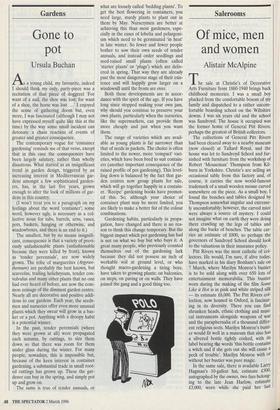Salerooms
Of mice, men and women
Alistair McAlpine
The sale at Christie's of Decorative Arts Furniture from 1860-1940 brings back childhood memories. I was a small boy plucked from the comfortable bosom of my family and dispatched to a rather uncom- fortable boarding school on the Wiltshire downs. I was six years old and the school was Sandroyd. The house it occupied was the former home of General Pitt Rivers, perhaps the greatest of British collectors.
The collections of General Pitt Rivers had been cleared away to a nearby museum (now closed) at Tallard Royal, and the house was let to Sandroyd School and fur- nished with furniture from the workshop of Robert `Mouseman' Thompson from Kil- burn in Yorkshire. Christie's are selling an occasional table from this factory and, of course, it carries the now world-famous trademark of a small wooden mouse carved somewhere on the piece. As a small boy, I found the benches and tables designed by Thompson somewhat angular and extreme- ly uncomfortably; however, the carved mice were always a source of mystery. I could not imagine what on earth they were doing there crawling up the legs of tables and along the backs of benches. The table car- ries an estimate of £800, so perhaps the governors of Sandroyd School should look to the valuations in their insurance policy.
Pitt Rivers was the most catholic of col- lectors. He would, I'm sure, if alive today, have marked in his diary Bonham's sale on 7 March, where Marilyn Monroe's bustier is to be sold along with over 650 lots of entertainment memorabilia. This bustier worn during the making of the film Some Like it Hot is in pink and white striped silk — its estimate £6,000. The Pitt Rivers col- lection, now housed in Oxford, is fascinat- ing in its diversity. There you can find shrunken heads, ethnic clothing and musi- cal instruments alongside weapons of war and the paraphernalia of a thousand differ- ent religious sects. Marilyn Monroe's busti- er would fit well in a museum that also has a silvered bottle tightly corked, with its label bearing the words 'this bottle contains a witch and if she gets out she will cause a peck of trouble'. Marilyn Monroe with or without her bustier was pure magic.
In the same sale, there is available LaffY Hagman's 10-gallon hat, estimate £300, autographed by the owner, two furs belong- ing to the late Jean Harlow, estimate £3,000, worn while she paid her last respects to her late husband Paul Bern, and Noel Coward's pen and ink bottle, estimate £400, which are accompanied by a signed photograph of Coward using the pen.
Also in the same sale is Errol Flynn's trunk and its contents. This lot was taken from Errol Flynn's debt-ridden yacht while it was moored off the French Riviera, and the trunk was formerly in the possession of Jack Warner of Warner Brothers. Its esti- mate is £5,000. Among its contents are four shirts, two floral ties from Cuban Rebel Girls, a pair of tights, underwear, pyjamas and a cummerbund. In its lower compart- ments, are unopened packs of cigarettes and three pheasant feathers,.
Errol Flynn's adventures were not just the stuff of Hollywood and celluloid, how- ever, for in his youth he earned his living as a crocodile hunter on the rivers of New Guinea. Flynn had previously been engaged in the pearling industry of north- ern Australia. Both these occupations in those days involved double-dealing and often downright piracy, while the reality of the heat, mosquitoes and the mangrove swamps made them somewhat less roman- tic than they sound. How ironic it is that Flynn's early life was far more hazardous than his 'deeds of daring do' on the screen.
Phillips on 6 March have a sale of fine European ceramics and glass where some of the lots are also not quite what they seem. There is, for instance, a mid-18th- century Chelsea figure which is an exact copy of an early 18th-century Chinese porcelain figure of a seated god — luckily for the vendor, this figure is not a genuine Chinese one, for if that were the case it would be worth £400, while as a Chelsea copy it is estimated to fetch £5,000. There is also in the same sale a small pear-shaped coffee pot estimated at £12,000. This pot was bought at a country sale and thought to be Chinese; it turned out, however, to have been made in England by the Bristol facto- ry between 1749 and 1751.
On 26 March, Christie's South Kensing- ton are holding a sale of Tribal Art that would have delighted the great General Pitt Rivers. I am certain that he would have acquired 'a pair of Aracuna goose feather breeches' that formerly belonged to the Indians of Chile, estimate £250. I am equally certain, however, that his collection already has several pairs of feather shoes used by Aboriginals, estimate £800, to con- duct ritual murders. These shoes were so constructed that you could not tell in which direction the murderers were walking, making them extremely hard to catch.
Collectors today have a problem collect- ing such items that was never faced by the general. So many of the feathers used in their construction come from endangered species and cannot be taken through the customs into other countries without a deal of trouble.



































































 Previous page
Previous page